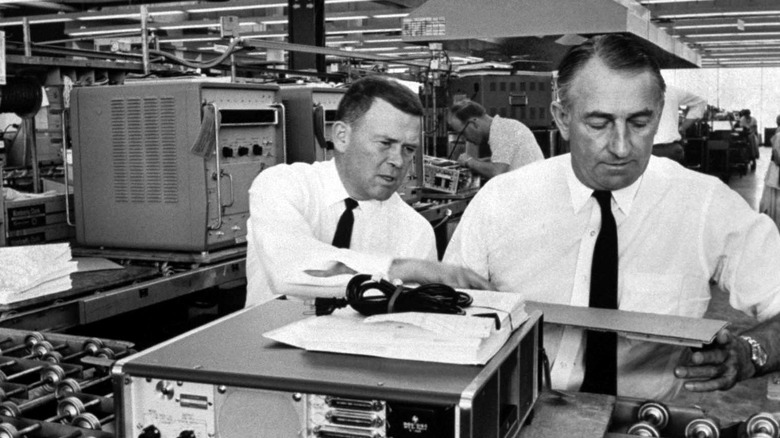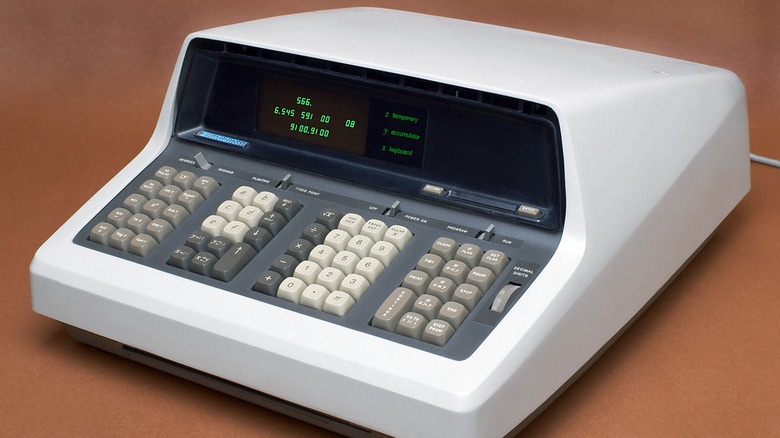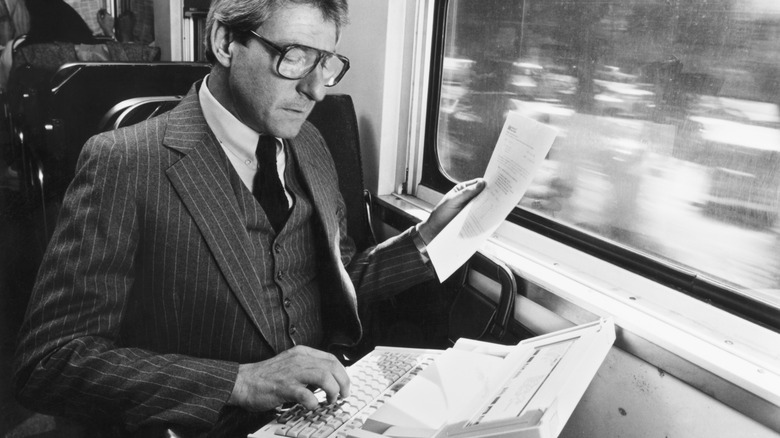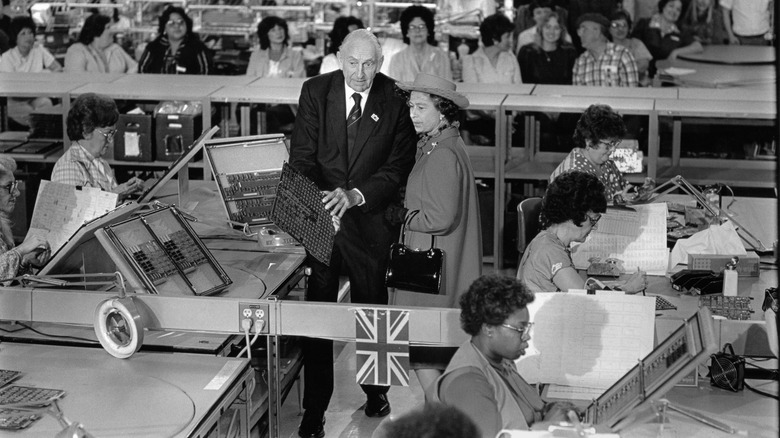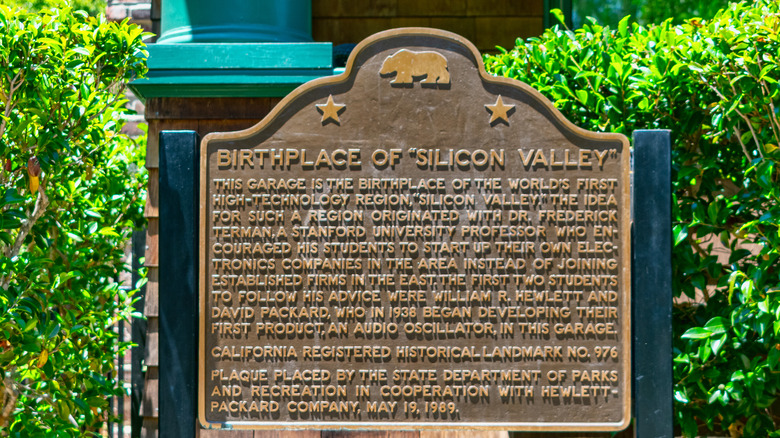Who Were William Hewlett & David Packard? The Men Behind A Global Tech Powerhouse
Some brands are so familiar that it's easy to forget that real people are behind their iconic names. Today, Hewlett-Packard is a multi-billion dollar international company with a 21.9% share of the PC market, making it the second-largest vendor in the world after Lenovo, but when William Hewlett and David Packard launched the company in 1939, things were more modest.
Hewlett and Packard met at Stanford University in the 1930s while studying electrical engineering. Before they finished their degrees, the pair discussed setting up a company to manufacture instruments for radio, which was the exciting new tech at the time. Professor Fred Terman, Head of Engineering at Stanford and a mentor to the pair, advised them to get a bit of experience under their belts first. After graduating, Packard went to work at General Electric, while Hewlett did a Masters at MIT before getting a job at Jensen Radio Manufacturing Company.
It wasn't long before they returned to their original plan of setting up a business together. The first official meeting took place in 1937 for what they planned to call The Engineering Service Company, focused on designing and manufacturing electronics. Later, they settled on the name Hewlett-Packard. Hewlett won a coin toss to decide whose name came first. And the rest, as they say, is history.
Silicon Valley began in their garage
The pair moved into a house on Addison Avenue in Palo Alto, California, in 1938. Packard and his wife, Lucile, rented the first floor, the landlady lived on the second floor, and Bill Hewlett slept in a small shed in the garden. The house came with a one-car garage that became their workshop. The garage is now a California-registered landmark with a placard declaring it "the birthplace of Silicon Valley.," a nickname that sprung up in the 1970s.
The company's first product was an audio oscillator — an instrument used for testing audio equipment. They called it the HP200A because they wanted to customers to believe they had a full product catalog.
The HP200A was exhibited at a conference, where it got a lot of interest, largely because it was originally priced at $54.40, almost a quarter of the price of its nearest competitor. One of its earliest clients was the Disney corporation, which wanted a slightly modified version of the oscillator. Disney bought eight HP200Bs to test audio equipment for the first screenings of Fantasia in 1940. David Packard was keen to downplay the significance of this early sale. In his book, "The HP Way," he writes, "It's been said if it wasn't for this sale to Disney, we might have gone out of business. The truth of the matter is that with or without the Disney sale, Bill and I were determined to move ahead with our company.”
They made the world's first personal computer
In the years that followed, Hewlett and Packard moved out of the garage and successfully manufactured a range of equipment, leading the field of electronic measuring instruments, producing signal generators, voltmeters, and audio oscillators.
In 1966, the company produced its first computer, the HP2116A, designed to be rugged enough to be used on ocean-going research vessels. The HP9100A, released in 1968, was a game-changer in the computing world. Although marketed as a desktop calculator, it was effectively the world's first PC. The term "personal computer" was used in some of its marketing. The company decided to market it as a programmable calculator because the term "computer" was associated with much larger hardware than Hewlett-Packard sold. Bill Hewlett said, "If we had called it a computer, it would have been rejected by our customers' computer gurus because it didn't look like an IBM."
Costing $4900.00 (around $45,000 in today's money), the HP9100A was still aimed at businesses rather than individual customers. The founders then set their sites on the direct-to-customer market.
They brought PCs into people's homes
Hewlett-Packard's first direct-to-customer product was the HP-35 Scientific Calculator in 1972. The first product of its kind — the scientific calculator — could handle "trigonometric, logarithmic, and exponential functions" and replaced the manual slide rule that engineers and scientists previously used. It cost $395 (over $3,000 in today's prices), and market research said that the high price point meant that it would never sell. Instead, it was an immediate hit. Bill Hewlett said, "We figured, in the first year, if we could sell 10,000 calculators, we'd break even. We sold 100,000." Hewlett-Packard developed its range of scientific calculators over the next few years, introducing programming features and magnetic card storage.
Desktop PCs for home use were the next revolutionary turning point. Hewlett-Packard's personal computers, starting with the HP85 in 1980, launched home computing by providing desktop computers at a relatively affordable price. The original 16K RAM had increased to 128K RAM by the time the HP-87XM was released in 1983. Hewlett-Packard computers in the 1980s originally came with cassettes for storage, and floppy disks were introduced in 1983.
Hewlett-Packard is now famous for its printers, but the first inkjet printer wasn't released until 1984. It was an immediate hit, providing a quieter, clearer, and cheaper alternative to dot-matrix printers.
Hewlett and Packard were often one step ahead of their competitors. In 1986, Packard decided to register the domain name "HP.com". It was only the ninth internet .com domain registered at the time because this was many years before the internet became mainstream.
Their company ethos was ahead of its time
Although Bill Hewlett and David Packard weren't personally involved in every product that the company released, they remained involved with the company throughout the eighties and nineties. Hewlett was CEO of HP until 1978 and served as vice-chairman of the board until 1987, after which he was given the title of director emeritus. He died in 2001. Packard was CEO until 1968, when he left the company to pursue a career in politics. He was the Deputy Secretary of Defense from 1969 to 1971 under President Richard Nixon. After that, he returned to Hewlett-Packard and was chairman of the board until his retirement in 1993, three years before his death in 1996.
Hewlett's and Packard's legacies included not only technological breakthroughs but also their pioneering company culture, "The HP Way" focused on fostering the careers of its employees and focusing on accomplishment over profits. Hewlett and Packard introduced profit-sharing schemes, medical insurance, and open-plan offices long before these were considered the norm in businesses.
Their legacy lives on today
Both men were keen philanthropists, setting up the William and Flora Hewlett Foundation and the David and Lucile Packard Foundation. Between them, they donated hundreds of millions of dollars to universities, schools, museums, and a non-profit oceanographic research center. Both also men made substantial donations to Stanford University in recognition of the key part it played in their success.
The company may have changed since the days of its founders, but everything that Hewlett-Packard does today is a direct result of the work of two ambitious men building oscillators in a rented garage. They inspired and mentored many of the tech giants who came after them. Aged 12, Steve Jobs phoned Bill Hewlett to ask for some spare parts for a school project. Impressed by the boy's enthusiasm, Hewlett gave Jobs a summer job working at Hewlett-Packard.
Steve Wozniak worked at the company in the 1970s designing calculators. While there, he developed the first Apple computer and offered the rights to Hewlett-Packard, who declined, proving that even the great minds behind Hewlett-Packard can get things wrong sometimes. As Hewlett reportedly said years later about the missed opportunity, "You win some, you lose some."
